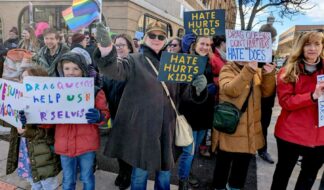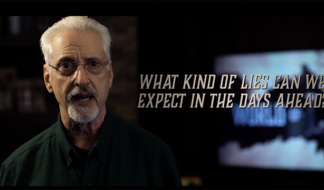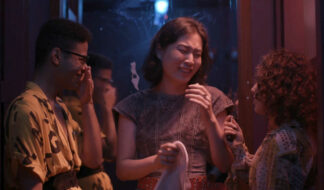by Bob Roehr
Centers for Disease Control and Prevention (CDC) researcher Richard J. Wolitski, speaking before a packed session on LGBT health at the annual meeting of the American Public Health Association (APHA), in Washington, DC Nov. 5, told those gathered, "Fifteen to 22 percent of gay and bisexual men experience physical abuse from an intimate partner during their lifetime. These rates are similar to what women experience from their male partners, but they are higher than that for men or women with female partners."
"In terms of childhood sexual abuse, men who have sex with men report rates that range between 12 and 37 percent in the literature. This is much higher than rates for other men, which typically range from 1 to 4 percent," Wolitski said.
Wolitski said gay and bisexual men largely have been invisible in health disparities research. Much of the work that has been done has focused on sexually transmitted diseases (STDs) and substance abuse, where the rates of occurrence often are several times higher among gays. However, many of those studies have used questionable methodology such as recruiting participants from gay bars or STD clinics, so those studies likely give a skewed picture of the community.
Wolitski acknowledged that individual behavior can play an important role in some of these disparities, but added "it is important to recognize that a focus on individual behavior alone is not going to be sufficient to address these disparities." As proof of the scope of homophobia, he cited a 2006 poll where 40 percent of Americans believed that sex between same-gender partners should be illegal. Lack of acceptance by family can also add to the burden of stress, sometimes affecting both mental and physical health.
Ronald Valdiserri, a CDC alumnus who is now a senior consultant at the Department of Veterans Affairs, said part of the explanation for higher rates of STDs is that men are men. "Regardless of the culture and regardless of the sexual preference, men on average consistently desired a larger number of partners than women," according to an international survey of 16,000 men and women in 52 countries. "So if you put two men together and they have those preferences, that is yet another reason for differences in disease rates."
Urban Mens Health Survey
The Urban Mens Health Survey "generated a whole set of really dismaying papers" on gay men's health, said Ron Stall, who worked on that study at CDC and is now at the University of Pittsburgh. It was an in-depth telephone survey of nearly 3,000 men in San Francisco, New York, Los Angles, and Chicago, conducted from late 1996 to early 1998.
It found high rates of distress and depression, attempted suicide, childhood sexual abuse, HIV infection, substance use, and partner violence. "It seemed to me that a lot of them were interconnected." Stall used the term "syndemic" to describe a number of interconnecting epidemics that "together drive these risks among gay men."
He looked for interconnections and found that gay men with current high levels of substance use were more than twice as likely to have current partner violence and were more likely to be depressed.
"There is a very strong dose effect–the more of these problems that the guys had, the more likely they are to have high risk sex, and the more likely they are to be HIV positive…It suggested to me is that we have at least four psychosocial conditions intertwining with each other that are driving HIV risk, and in turn driving an infectious disease."
"You had a syndemic situation going on among a group of men, 80 percent of whom were college graduates, three-quarters of them were white, who were living in some of America's richest zip codes, and yet they had a health profile that looked like they were living in a favela [hillside slum] in Brazil."
"If you look at the literature on gay men ages 18-22, you see immediately that the syndemic conditions are all in place among very young gay men. Something horrible is happening to young MSM as they are coming of age."
The hypothesis
Stall said most studies of homophobia have looked at how it affects adults. Part of the reason for that is the difficulty of obtaining informed consent from parents to conduct research among minors. "But if homophobia is a culture-wide phenomenon, it affects everyone–including kids."
"The experience of homophobic attacks, particularly at a very young age, leaves men vulnerable to greater rates of mental health and substance abuse disorders, that together spin out of control."
Adolescence is a particularly vulnerable time of sexual awakening that often is accompanied by the lack of a secure sense of identity. "Many kids don't have the social support that we as adult men can get when somebody calls us a bad name or tries to beat up us. They can't go anywhere, they can't talk about it, they don't understand what is happening to them, they don't have the coping skills."
Stall said, all activity of young boys "is about competition for masculinity…they knock the socks off of you if you lose. You are socially shamed for not winning masculinity…Kids who lose at competing for masculinity become the object of masculinity panic. It happens to any kid who doesn't fit in."
He said they have identified three tiers of kids based on when they became aware they were gay. "The early bloomers first realized they were attracted to another boy in the second grade. They first started wondering whether they were gay by the fifth grade. By the ninth grade they had their first sex, and immediately decided they were gay. And they told somebody before they left high school."
"It turns out that the kids who come out early ended up being punching bags. About a quarter of them were beaten up by their parents before they were 17; about three-quarters were harassed by 17; and 1 in 5 had forced sex before they were 18. Even the late bloomers had very high rates of violence and victimization as they were coming of age."
Looking at the literature, he said, gay men are about three times more likely to have been the victim of violence as a child. There also is a correlation between the amount of violence experienced as a child and poorer health status later in life.
Stall believes it is vitally important to build support networks for youth who do not fit into the traditional stereotype roles of masculinity. It also is important to change the expectations of society on gender roles. Unfortunately, there is virtually no good long term data on what does and does not work toward accomplishing those ends.









